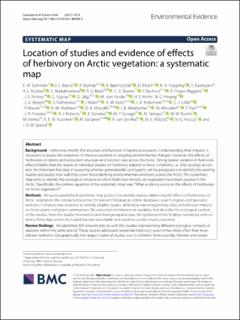Location of studies and evidence of effects of herbivory on Arctic vegetation: a systematic map
Soininen, Eeva M; Barrio, Isabel C.; Bjørkås, Ragnhild; Björnsdóttir, Katrin; Ehrich, Dorothee; Hopping, Kelly A.; Kaarlejarvi, E.; Kolstad, Anders Lorentzen; Abdulmanova, Svetlana; Björk, Robert G.; Bueno, C. Guillermo; Eischeid, Isabell; Higgens, Rebecca Finger; Forbey, Jennifer; Gignac, Charles; Gilg, Olivier; Herder, Michael den; Holm, H. S.; Hwang, Bernice; Jepsen, Jane Uhd; Kamenova, Stefaniya; Kater, Ilona; Koltz, Amanda; Kristensen, Jeppe A.; Little, Chelsea J.; Macek, Petr; Mathisen, Karen Marie; Metcalfe, Daniel B.; Mosbacher, Jesper Bruun; Mörsdorf, M.; Park, Taejin; Propster, Jeffrey; Roberts, Aradhana J; Serrano, E; Spiegel, Marcus P.; Tamayo, Mariana; Tuomi, Maria Wilhelmina; Verma, Megha; Vuorinen, Katariina Elsa Maria; Väisänen, Maria; Wal, Rene van der; Wilcots, Megan; Yoccoz, Nigel; Speed, James David Mervyn
Peer reviewed, Journal article
Published version
Permanent lenke
https://hdl.handle.net/11250/3030910Utgivelsesdato
2021Metadata
Vis full innførselSamlinger
Sammendrag
Herbivores modify the structure and function of tundra ecosystems. Understanding their impacts is necessary to assess the responses of these ecosystems to ongoing environmental changes. However, the effects of herbivores on plants and ecosystem structure and function vary across the Arctic. Strong spatial variation in herbivore effects implies that the results of individual studies on herbivory depend on local conditions, i.e., their ecological context. An important first step in assessing whether generalizable conclusions can be produced is to identify the existing studies and assess how well they cover the underlying environmental conditions across the Arctic. This systematic map aims to identify the ecological contexts in which herbivore impacts on vegetation have been studied in the Arctic. Specifically, the primary question of the systematic map was: “What evidence exists on the effects of herbivores on Arctic vegetation?”.

